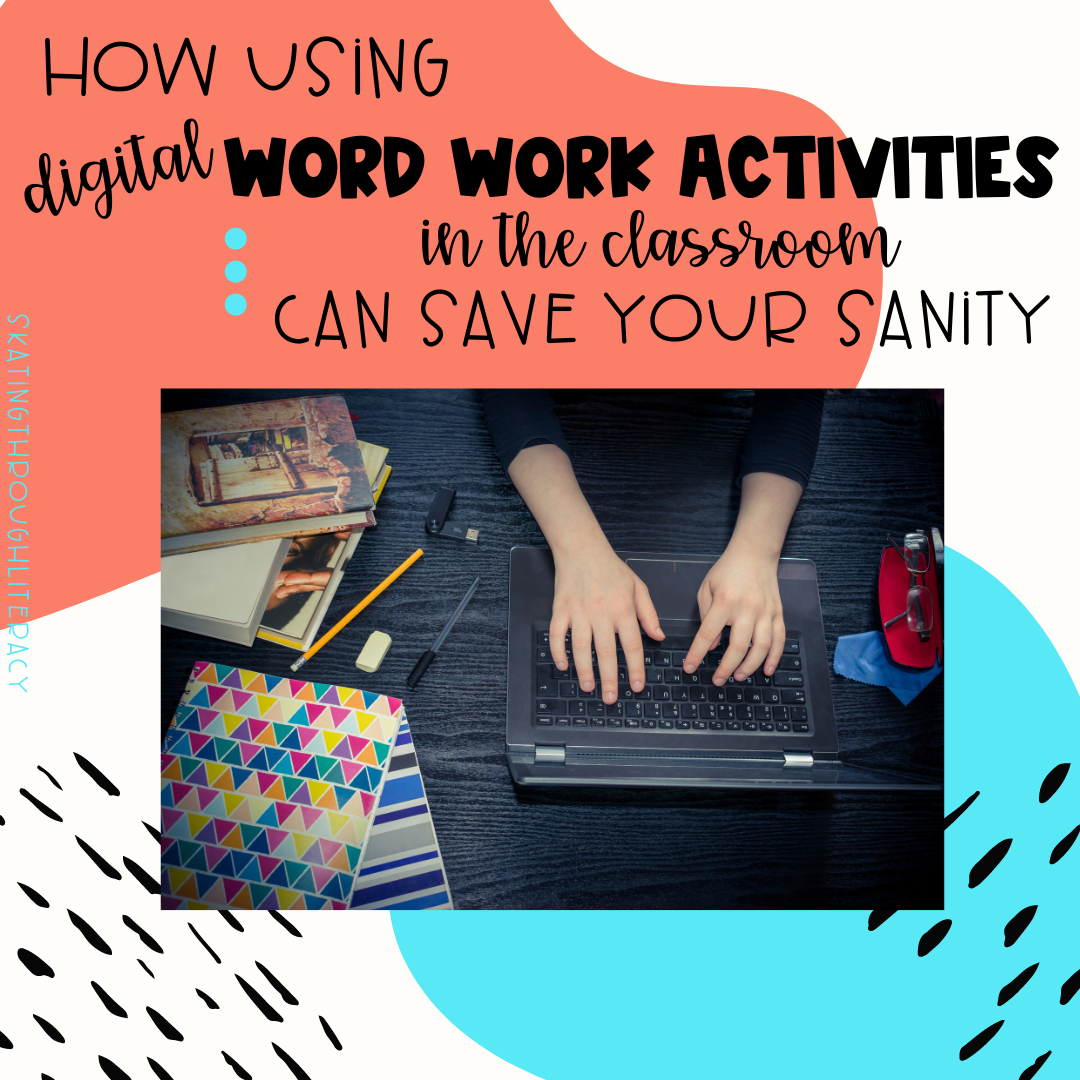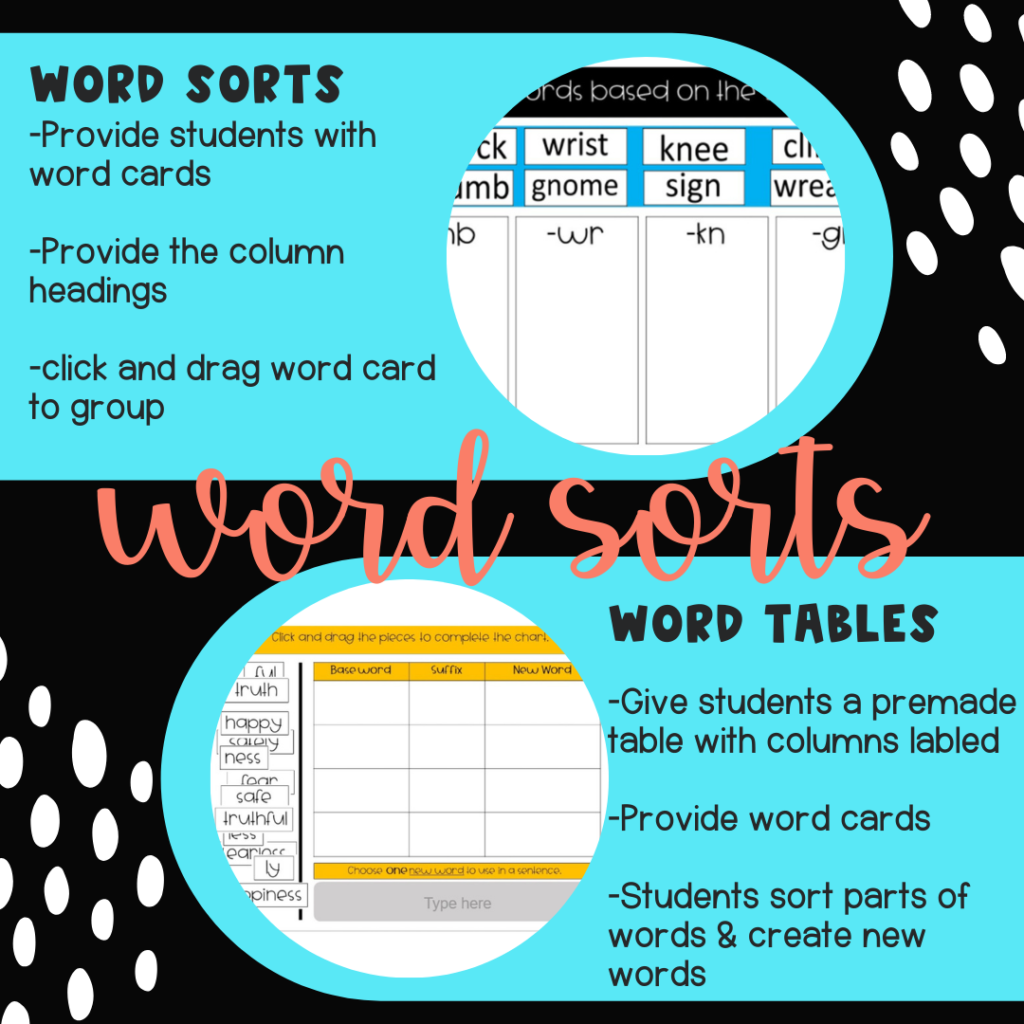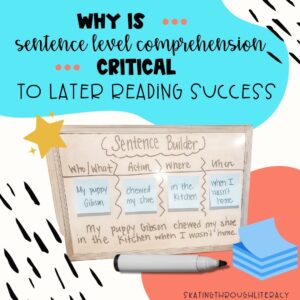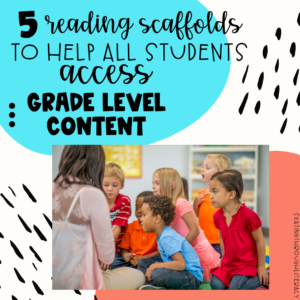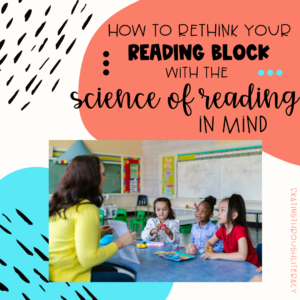Digital word work activities are one of those happy takeaways from the global pandemic we’ve endured over the past two years. And there just aren’t that many happy takeaways I can think of. Which gives all the more reason to celebrate the world of digital word work.
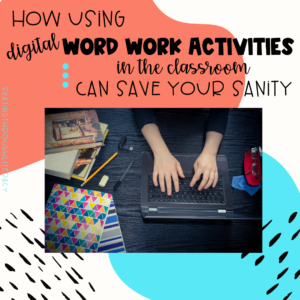
Much like millions of educators, when I was suddenly sprung from the classroom into my basement to continue the same job, with no resources and no training on what that might look like, I panicked. This left so many feelings of juxtaposition of what I was being asked to do vs what I actually felt capable of doing. This sudden urge to reproduce all my educational strategies in a new online way created a perfect environment for innovation and adopting change. Because that was truly the only option.
During the heart of the pandemic, I was fully virtual for a year and half of instruction. This led to an arsenal of new digital skills I picked up along the way. When finally allowed back for in person learning, these new strategies came with me. Instead of juggling a bunch of centers, manipulatives, worksheets, and folders, I found some of these digital skills could take away some of the stress and management of my once complicated word work routines. Not to mention the benefits of digital word work activities for those students stuck at home in quarantine. Oor the vast amount of other reasons students were missing class.
Digital word work activities were quickly becoming a huge sanity saving aspect in my post pandemic teaching. And now I want to help save some of your sanity as well. Because if you’re still in the classroom after what has been the past two years, you deserve as many sanity saving tips as you can get!
Word work
Before diving into the world of digital word work, it’s important to define what I mean when discussing word work. I began my teaching career under a reading workshop model; heavily emphasized with the Daily 5. I learned the importance of regular sustained practice of working with words for my young readers. If you’re unfamiliar with the word work routines as taught by Daily 5, you can learn more at the Daily 5 website.
Establishing a word work routine at the beginning of your school year is crucial. It will set the tone for the importance of working with words. Also, it will provide you with a structure in which you can differentiate for the multiple sets of needs in your classroom. If you want to learn more about how I launch word work at the beginning of the school year, you can check out this blog post where I go in depth on getting started.
Shifting from balanced literacy to the science of reading.
Since my original training of a balanced literacy approach, I have been undergoing a dramatic shift around the Science of Reading. I have spent the past 2 years becoming LETRS trained, learning as much as I can about how students learn to read. This has changed the way in which I view many practices in my classroom. However, the emphasis on working with words only continues to grow. Students need explicit instruction on the code of our English language and ample time to develop and practice those skills. I now believe word work activities need to be much more structured in their approach.
The shift from balanced literacy word work to the science of reading word work is not as intimidating as one might think. With small but incredibly meaningful changes, word work can be a beneficial part of a students reading development.
Here are some easy examples of changes you can make to your word work activities:
- Instead of allowing kids to explore with magnet tiles, give students a structured list of words to build around the sound pattern they have already been taught using a phoneme grapheme mapping board
- Instead of students completing a rainbow write of their words, have them create a sound rainbow write where each sound is represented by a color, rather than a letter
- Instead of using shape boxes that focus on what each letter looks like, use a sound box template where students focus on the sounds within the word
Digital word work
So where does the digital aspect enter in all this discussion of word work? While I believe there will always be a need for physical manipulatives such as blocks and letter tiles, the world is moving to a more digital future. Students are born with technology in their hands. Often I find my students much more capable of manipulating a mouse on a screen or a complicated google slide before they can even make a lowercase a correctly.
Through the pandemic I discovered a treasure trove of resources. This allowed me to create almost any activity I used to do in person in a new digital way. Here are some of my favorite ways I used digital word work during instruction with both whole and small groups.
-
Jamboards in place of traditional word building with blocks
Using Jamboards I was able to teach digital word work to my students in countless ways. I could use sticky notes, create letter blocks, create dictation sheets, and upload different backgrounds I needed that the students could not manipulate.

-
Peardeck for digital word work instruction focused on sound
Peardeck is another free extension from google. It gives teachers so many options in how students can interact with the material. Peardeck is a great resource to target sounds because the teacher can control the pace of the lesson. This allows you as the teacher to give explicit questions targeting the sound you are teaching. It also gives students the opportunity to interact with the content at the same time. For example, if I was teaching the au sound like the au in pause, I could give students a slide with 12 different words on it. They could use different chips to identify which of those words make the same sound as the au in pause. Another sanity saving benefit is this allows for each student to individually interact with the lesson without the need to get out a bunch of supplies.

-
Nearpod for a variety of digital word work activities with instant reports
Nearpod is a great website that allows you to build interactive lessons for your students. There are a variety of ways to input interactive parts into each section. These include fill in the blanks, multiple choice, matching, videos, pdfs, and a fun interactive game called time to climb. During a time to climb students choose avatars that advance as they answer questions completely. Students can see their classmates progress on the mountain as well.

Digital word work activities
Once my students have received direct instruction, they need ample opportunity to practice those skills. One way I love to give them a variety of applications is through my digital word work.
The interactive digital word work is set up for google slides so I can easily share it. Students each get their own set of slides. My interactive word work is structured in a 3 round setting. This allows me to differentiate for each group either how much to complete, what types of questions to complete, or picking and choosing what each student might need.
There are a variety of activities within each round. Here are some examples of the types of activities:
1. Word sorts
Word sorts are a great way for students to practice identifying the phonics pattern being studied.
2. Sound focused activities
Students benefit from practice that focuses on the sounds that letters represent; rather than pure memorization of a word. These types of activities in which students must distinguish the different sounds they hear in words is incredibly beneficial. These two examples of activities give students practice with this skill in two different formats. One skill has the students identifying and typing a word that represents a vowel sound. The second activity gives students a word bank of choices that they must cover if they hear a certain sound. I also love both of these because it inherently makes the students think about each sound.
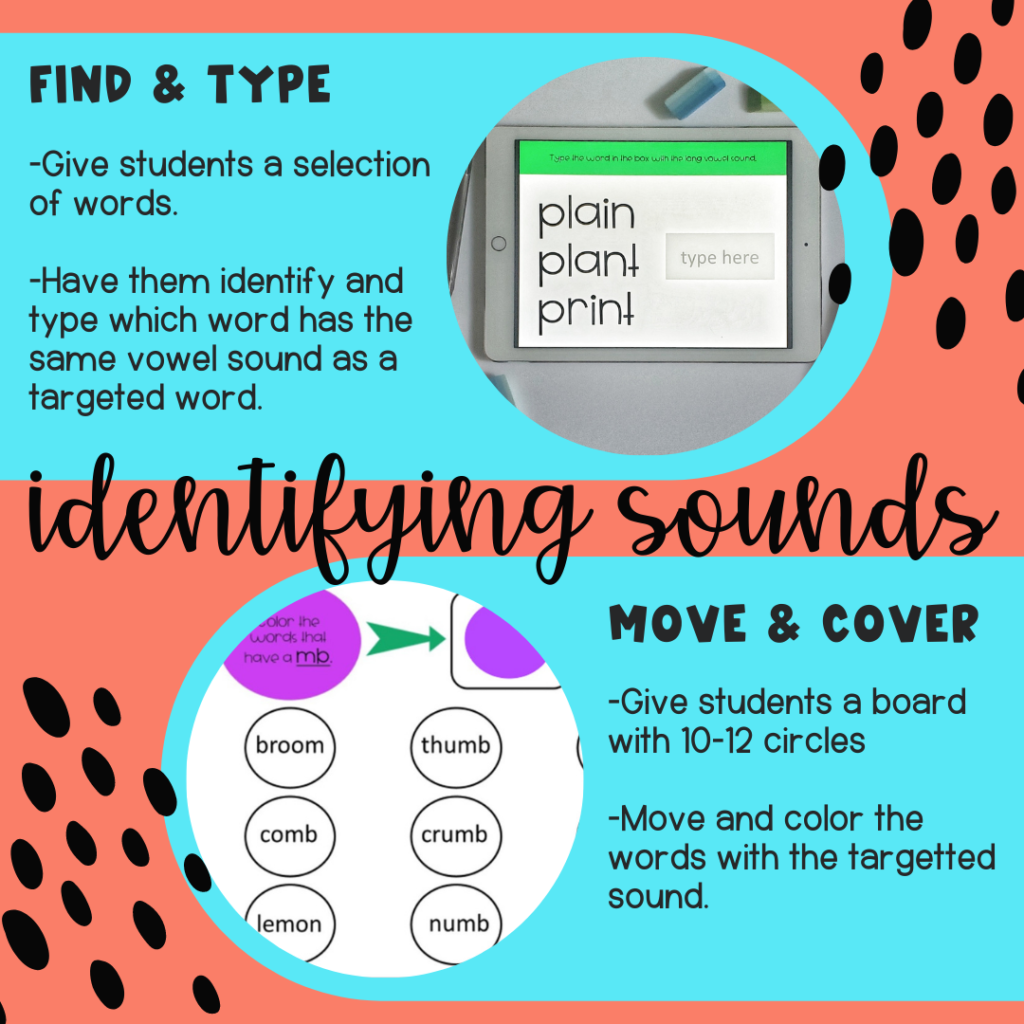
3. Number of Sounds & Syllables
Hearing parts of words, whether it be the individual sounds in a word or the number of syllables in a word, is a critical skill developing readers need. These types of activities focusing on the sounds and syllables are great for students to practice independently. The phoneme grapheme mapping activities has students break each word down into individual sound parts. The syllable activity has students decide if each word has two or three syllables.
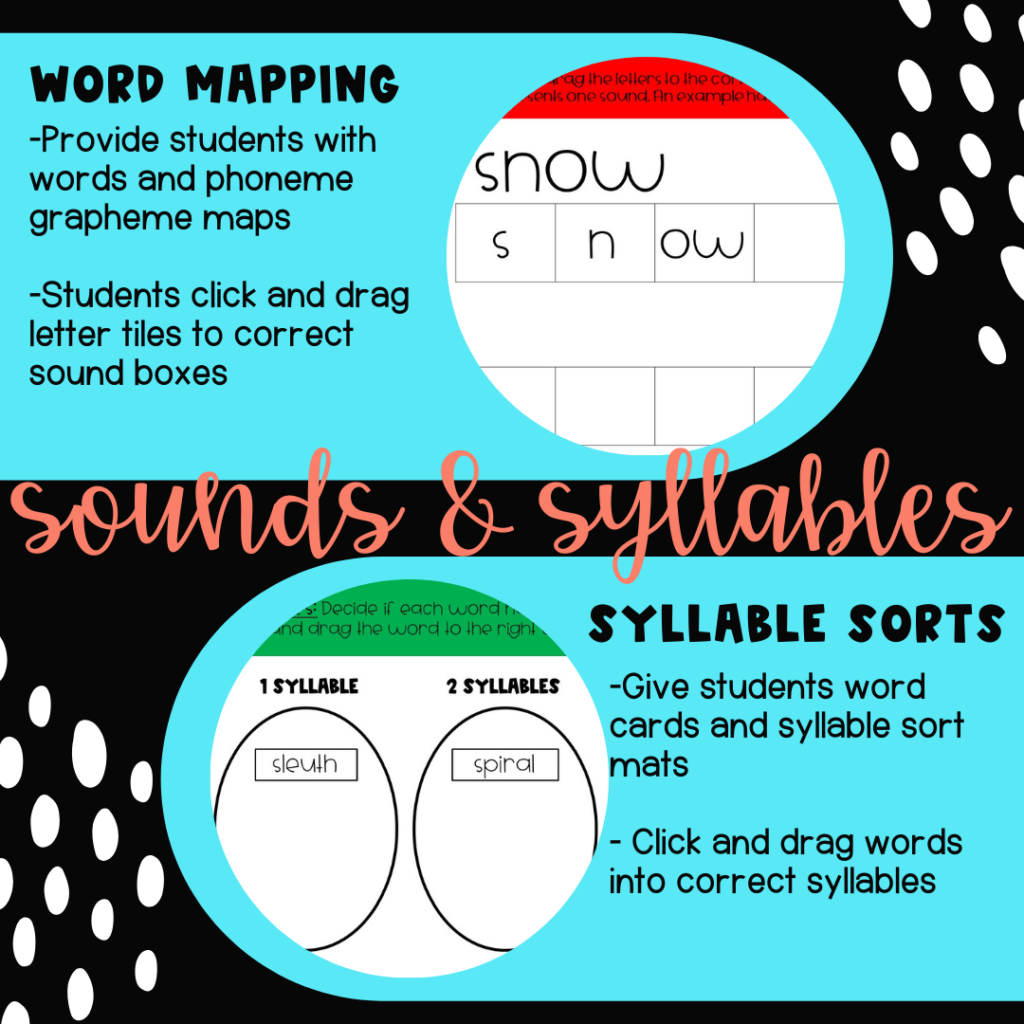
Digital word work can be such a time saver for you in the classroom. By eliminating the need for individual supplies, it can save you time spent managing materials and sanitizing. Digital word work can also save you with time to grade, making the process more automatic. The possibilities of platforms and question types that utilizing digital word allows really stretches your students ability to work with words. All of these things make digital word work a must for me when it comes to a few sanity saving moments in the classroom!

